Remote Sensing Based Sugarcane Yield Prediction Model using Artificial Intelligence
Keywords:
Sugarcane, Yield prediction, Predictor variables, Time series vegetation index (VI), phenology measurements, normalized difference vegetation index (NDVI)Abstract
Automation is playing an increasingly important part in today’s professions and in every field of life. Remote-sensing based sugarcane yield prediction is more effective than old yield-prediction techniques. Traditional yield measurement techniques include the time and labor-intensive destructive sampling of sugarcane fields. Accurate and timely yield forecasts help decision-making processes such as crop harvesting plans, milling, marketing, and forward selling strategies, which boosts the efficiency and profitability of the global sugar sector. At the moment, destructive or visual sampling techniques are used by producers or productivity officers paid for by mills to assess production during the growing season. People want to get things done in the quickest and most efficient way to solve the problems. The use of machinery for sugarcane cultivation has increased significantly over a wide area to lower production costs, decrease farmers' labor demands, and improve harvest efficiency. Although they have not been thoroughly compared, existing techniques for estimating agricultural output using regression typically rely on a specific set of forecasting factors. For monitoring agriculture, which makes use of satellite earth observation data, this study illustrate and compare the use and using several sets of object-based predictors to estimate sugarcane production. Several regression models compared utilizing a variety of different predictor variables. In this study, the yield of the sugarcane measured by using regression models, time series of the vegetation index (VI), remote sensing, phenology measurements, and the normalized difference vegetation index (NDVI). Artificial intelligence algorithm models (Random Forest and Ordinary Least Squares) used to construct the suggested way to accurately relate ground-measured data. This work presents novel sugarcane yield prediction technique that improves forecasting accuracy.
Downloads
Published
How to Cite
Issue
Section
License
This is an open Access Article published by Research Center of Computing & Biomedical Informatics (RCBI), Lahore, Pakistan under CCBY 4.0 International License





